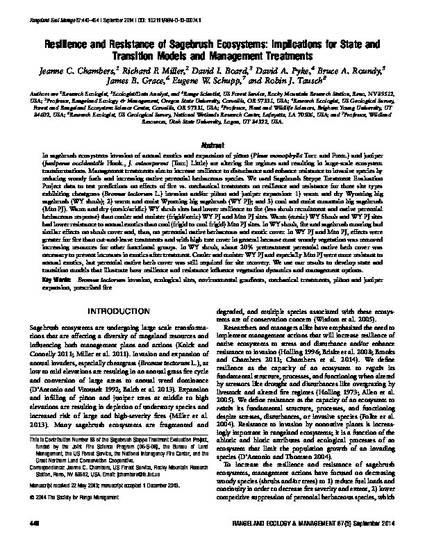
Article
Resilience and Resistance of Sagebrush Ecosystems: Implications for State and Transition Models and Management Treatments
Rangeland Ecology & Management
(2014)
Abstract
In sagebrush ecosystems invasion of annual exotics and expansion of piñon (Pinus monophylla Torr. and Frem.) and juniper (Juniperus occidentalis Hook., J. osteosperma [Torr.] Little) are altering fire regimes and resulting in large-scale ecosystem transformations. Management treatments aim to increase resilience to disturbance and enhance resistance to invasive species by reducing woody fuels and increasing native perennial herbaceous species. We used Sagebrush Steppe Treatment Evaluation Project data to test predictions on effects of fire vs. mechanical treatments on resilience and resistance for three site types exhibiting cheatgrass (Bromus tectorum L.) invasion and/or piñon and juniper expansion: 1) warm and dry Wyoming big sagebrush (WY shrub); 2) warm and moist Wyoming big sagebrush (WY PJ); and 3) cool and moist mountain big sagebrush (Mtn PJ). Warm and dry (mesic/aridic) WY shrub sites had lower resilience to fire (less shrub recruitment and native perennial herbaceous response) than cooler and moister (frigid/xeric) WY PJ and Mtn PJ sites. Warm (mesic) WY Shrub and WY PJ sites had lower resistance to annual exotics than cool (frigid to cool frigid) Mtn PJ sites. In WY shrub, fire and sagebrush mowing had similar effects on shrub cover and, thus, on perennial native herbaceous and exotic cover. In WY PJ and Mtn PJ, effects were greater for fire than cut-and-leave treatments and with high tree cover in general because most woody vegetation was removed increasing resources for other functional groups...
Disciplines
Publication Date
2014
DOI
https://doi.org/10.2111/REM-D-13-00074.1
Citation Information
Eugene W. Schupp. "Resilience and Resistance of Sagebrush Ecosystems: Implications for State and Transition Models and Management Treatments" Rangeland Ecology & Management Vol. 67 Iss. 5 (2014) p. 440 - 454 Available at: http://works.bepress.com/eugene_schupp/140/
